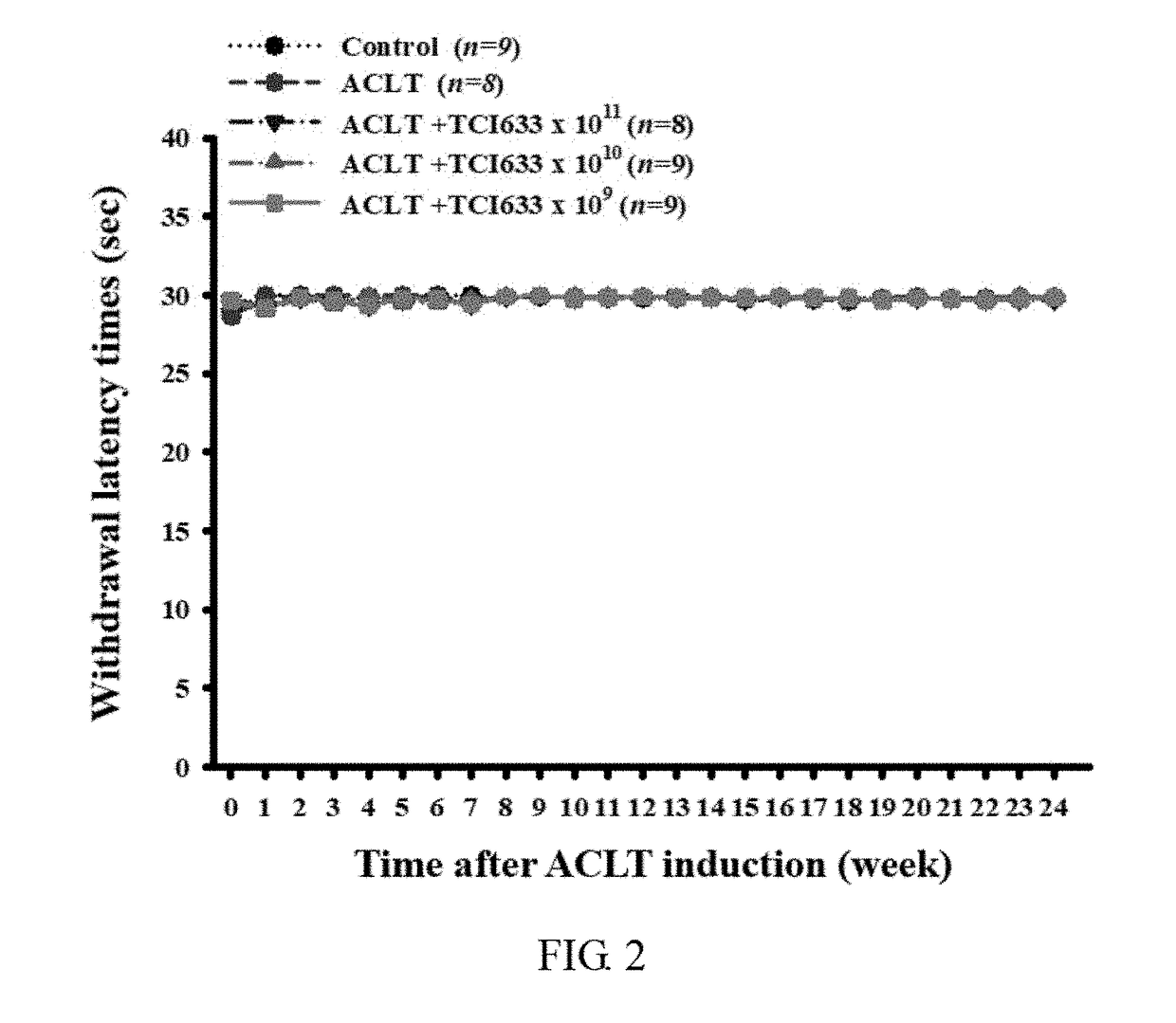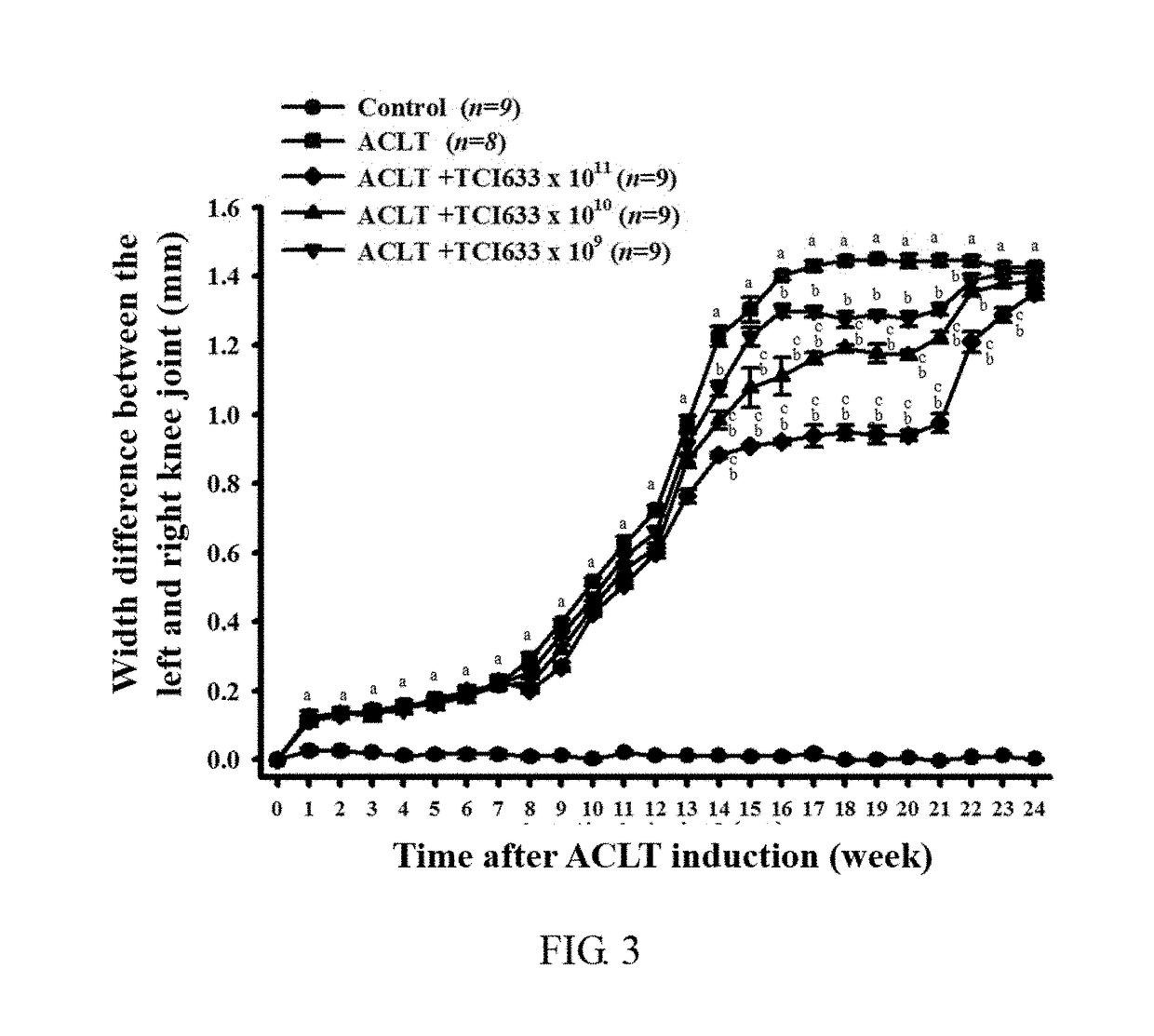Use of streptococcus thermophilis tci633 in treating arthritis
a technology of streptococcus thermophilus and tci633 is applied in the field of use of streptococcus thermophilus tci633 in treating arthritis, which can solve the problems of osteoporosis, deformity and other symptoms, pain, swelling, etc., and achieve the effects of relieving tissue inflammation, relieving joint pain, and alleviating joint swelling
- Summary
- Abstract
- Description
- Claims
- Application Information
AI Technical Summary
Benefits of technology
Problems solved by technology
Method used
Image
Examples
example 1
Changes of Hind Paw Weight Bearing Distribution
[0038]Changes in weight bearing distribution between the paw with degenerative joint resulting from the ACLT and the paw in contralateral control group hind were utilized as an index of joint pain of osteoarthritis (Bove et al, 2006). Dual Channel Weight Averager (Singa Technology Corporation, Taiwan) was used to measure the weight borne by the left and right hind paws. First, rats were placed in a sloped channel so that each hind paw was standing on a separate scale which measured the weight borne by the left and right paws. After the rats were in a stable position and calm, the measurement button was pressed to record data after three seconds. The results were calculated by subtracting the paw with degenerative joint (right paw) from normal paw (left paw) (Fernihough, et al., 2004). This test was performed weekly from weeks 1 to 24 after the baseline measurements of animal behavior and the ACLT surgery, and the results are shown in FI...
example 2
yperalgesia Test
[0040]A thermal hyperalgesia test was performed according to the method disclosed in the paper published by Hargreaves et al. in 1988 by irradiating the animal's paw with a low-energy radiant heat light source to measure the withdrawal latencies. The thermal hyperalgesia behavior was analyzed by a plantar test. A Plantar Stimulator Analgesia Meter (Life science, SERIES 8 IITC Model 390, USA) was used and adjusted to an active intensity of 25. To avoid rats' paw tissue from suffering from long-term heat damage, the cut-off time for the irradiation was set to 30 seconds (Hargreaves et al., 1988). To assess nociceptive responses to thermal stimuli, rats were placed on an acrylic glass platform, and the middle area of the paws of the rats was exposed to a thermal source stimuli. Observation was made to record how long it took the rats to lift their paws off the platform. This test was performed weekly from weeks 1 to 24 after the baseline measurements of animal behavior ...
example 3
l Allodynia Test
[0042]The effects of TCI633 on ACLT-induced mechanical allodynia were evaluated according to the method disclosed in the paper published by Chaplan et al. in 1994. The rats were placed in a brown acrylic box with a wire mesh bottom and allowed to acclimate for 15 minutes. Then, perpendicular pressure was applied by Von Frey filaments (Stoelting, Wood Dale, Ill., USA) from the bottom to the top to the hind paws of the rats. The intensity of the pressure was gradually increased from 1 g until the paw withdrawal behavior appeared, and then the pressure value was recorded as the withdrawal threshold. The pressure applied lasted for no more than 5 seconds each time, and the measurement was repeated for 3 times to ensure the accuracy of the data. Stimuli were presented at 15-second intervals or longer (Chaplan et al., 1994), and the results are shown in FIG. 3.
[0043]As shown in FIG. 3, ACLT group showed a significant reduction in the threshold of the withdrawal response fr...
PUM
 Login to View More
Login to View More Abstract
Description
Claims
Application Information
 Login to View More
Login to View More - R&D
- Intellectual Property
- Life Sciences
- Materials
- Tech Scout
- Unparalleled Data Quality
- Higher Quality Content
- 60% Fewer Hallucinations
Browse by: Latest US Patents, China's latest patents, Technical Efficacy Thesaurus, Application Domain, Technology Topic, Popular Technical Reports.
© 2025 PatSnap. All rights reserved.Legal|Privacy policy|Modern Slavery Act Transparency Statement|Sitemap|About US| Contact US: help@patsnap.com



